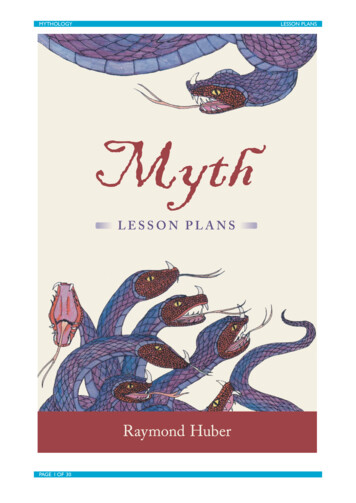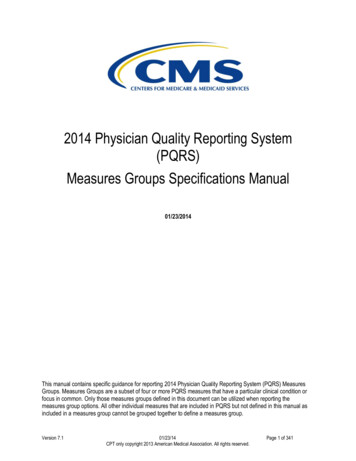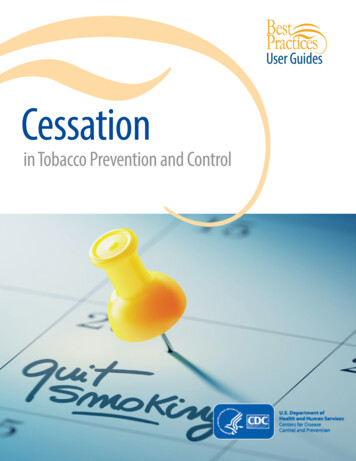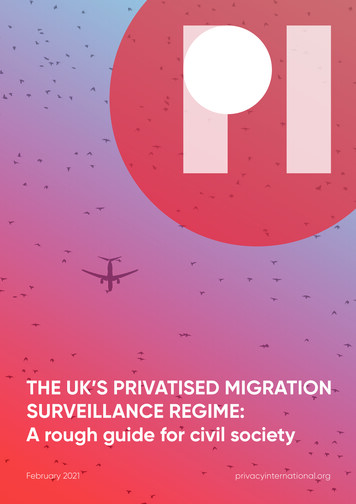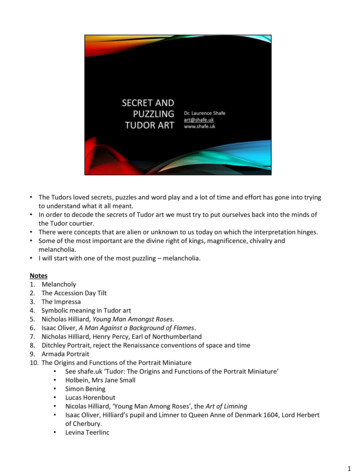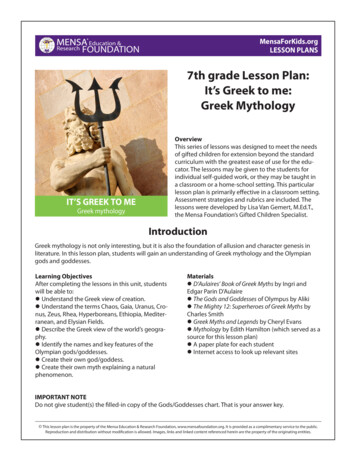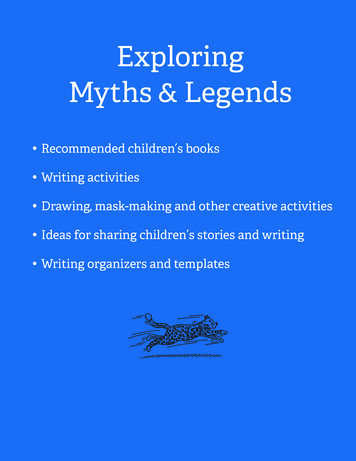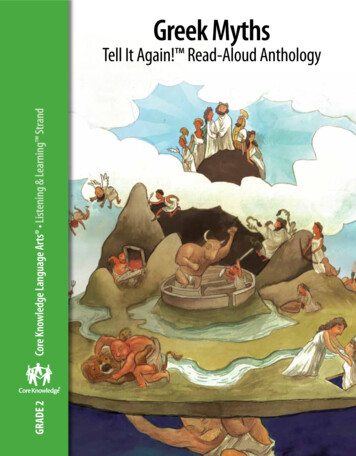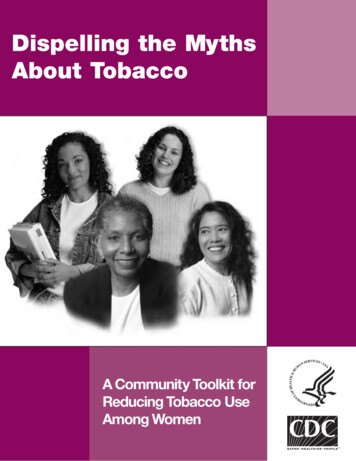
Transcription
Dispelling the MythsAbout TobaccoA Community Toolkit forReducing Tobacco UseAmong Women
Dispelling the Myths About TobaccoA Community Toolkit for ReducingTobacco Use Among WomenOffice on Smoking and HealthNational Center for Chronic Disease Preventionand Health PromotionCenters for Disease Control and PreventionAtlanta, GaSeptember 2001
Dear Women’s Health Advocates:In March 2001, U.S. Surgeon General David Satcher and Secretary of Health and HumanServices Tommy Thompson released Women and Smoking: A Report of the Surgeon General.This crucial report, the first in more than 20 years to focus on the issue of women and tobaccouse, concludes that the single greatest preventable threat to the health, safety, and welfare ofwomen around the world is tobacco.To assist health care providers, public health professionals, teachers, faith-based and communitygroups, concerned citizens, and other community leaders in addressing this threat, the Centersfor Disease Control and Prevention (CDC) has produced this companion toolkit. It is designed tohelp you lead girls and women toward the ultimate goal of happy, healthy, and smoke-free lives.The purpose of this toolkit is to apply what we have learned about why girls start smoking, whatkeeps women smoking, and what it takes to quit.This toolkit includes suggestions and ideas in the form of presentations, programs, mediaoutreach, and other activities. It is organized into tabulated sections so that you can go quickly tothe parts that fit your needs, your style, or your audience, and so that you can add, delete,highlight, and edit as you learn through practice. An important highlight is a 17-minuteeducational video, Women and Tobacco: Seven Deadly Myths, narrated by Christy Turlington.We’ll also be adding toolkit updates and additional resources to our Web site, www.cdc.gov/tobacco, so please check back often to see what’s new as well as to view the full SurgeonGeneral’s report and other report-related materials that we’ve prepared.If you need more help, let us know. Providing us with feedback, especially by completing andreturning the evaluation form at the end of this kit, will help us better serve your needs. Together,we can succeed in one of the most remarkable reform movements in history.Sincerely,Rosemarie Henson, MSSW, MPDirectorOffice on Smoking and HealthNational Center for Chronic DiseasePrevention and Health Promotion
A Community Toolkit for Reducing Tobacco Use Among WomenDispelling the Myths About Tobacco:A Community Toolkit forReducing Tobacco Use Among WomenContentsVideo—Women and Tobacco: Seven Deadly MythsDiscussion Guide for Women and Tobacco: Seven Deadly Myths . 5Video Posttest . 9Education and Outreach Activities . 11Community Activities . 11School Activities . 14College Campus Activities . 16Health Care Provider and Insurer Activities . 18Help With Quitting . 21You Can Quit Smoking: Consumer Guide . 21Cessation Resources . 25How to Be Heard: Making the Media Work for You . 27Media Advocacy . 27News Conferences . 33Sample Talking Points . 35Sample News Release . 37Op-Eds and Letters to the Editor . 39Proclamations and Resolutions . 43Media Campaign Resource Center (MCRC) . 45Internal Industry Documents Targeting Women . 47Searching Tobacco Industry Documents: Basic Information,Steps, and Hints . 47Excerpts About Women From Internal Industry Documents . 53More References & Resources . 61Appendix—Materials From Women and Smoking: A Report of theSurgeon GeneralExecutive SummaryAt a GlanceFact SheetsToolkit Feedback Form3
A Community Toolkit for Reducing Tobacco Use Among WomenDiscussion Guide forWomen and Tobacco: Seven Deadly MythsIf you or someone you love smokes, listen up!You CAN quit. And when you do, you willknow how good it feels to take control of yourhealth. I know because I’m one of the womenwho have kicked the habit. It’s one of the bestthings I ever did.Christy TurlingtonThe CDC video Women and Tobacco: Seven Deadly Myths was produced toreach women, particularly those between the ages of 18 and 34. Its narrator,Christy Turlington, cover model, entrepreneur, and volunteer tobacco controladvocate, is a well-recognized and powerful messenger. She is motivated bythe loss of her father to tobacco, her own long-term addiction to cigarettes,and her personal success in finally kicking the tobacco habit for good.Seven Deadly Myths aims to dispel some of the most powerful untruths thathave captured and kept girls and women as smokers. Most of these myths havebeen perpetrated by tobacco advertising and promotion, but over time,smokers internalize these fictions to rationalize and defend their addiction.You may want to begin your presentation by showing and discussing the video.It will focus your audience and give them information, ideas, motivation toquit if they smoke, and motivation to stay free from tobacco if they don’tsmoke. We hope that it will also encourage them to help others become andstay tobacco free.Personalizing your presentation will make it more powerful. Not everyone inyour audience may be able to relate to Christy, but every community has itsown “stars” of tobacco control, including ex-smokers who can presenttestimonials, offer hope, serve as examples, and support those who need helpto quit and stay tobacco free.The previewing questions below can serve as a benchmark or pretest for youraudience. At the end of your presentation, you can review the same questionsto reinforce the learning that has occurred. You can also administer the posttestto measure how your audience has changed in terms of knowledge, awareness,attitudes, and readiness to quit.Use the results of the evaluation and other feedback that you get to becomebetter at convincing women to become and stay tobacco free.5
Dispelling the Myths About TobaccoI. Viewing Objectives:After watching this video, participants will be able to1. Discuss the myths that surround women and smoking.2. Define some of the serious health effects of smoking on women.3. Describe the benefits of quitting smoking.II. Previewing QuestionsAre the following statements true or false? (Answers at bottom of page 7)1. Lung cancer, which is almost entirely caused by cigarette smoking, isresponsible for more deaths among women than breast cancer.2. As many as one-half of long-term smokers will die of causes related totobacco.3. Most teenagers who smoke daily do not expect to continue smoking, butmost are still smoking 5 years later.4. Women who smoke are more likely to have smaller, sicker babies, beinfertile, and have more miscarriages.5. Tobacco companies have known about the destructive health effects oftobacco and the addictive power of nicotine for at least 40 years.6. Cigarette smoking is the leading preventable cause of death in theUnited States.7. Light cigarettes have the same ingredients as regular cigarettes,including lead, ammonia, benzene, DDT, butane gas, carbon monoxide,arsenic, and polonium 210.8. More than 50 million Americans have quit smoking.III. Discussion QuestionsDiscuss the quotes from the video and answer the questions that follow.Myth #1: It won’t happen to me.“It’s not how I visualize myself dying.”“I can’t get lung cancer. I’m only 24.” Why do some young women start to smoke even though they knowthat smoking can damage their health? Why do you think people like Pam Laffin keep smoking even aftersmoking has begun to destroy their health?Myth #2: It’s not like I’m hurting anyone but myself.“Smoking is a civil right worth fighting for.”“Secondhand smoke causes at least 35,000 deaths a year innonsmokers.” Should all Americans have the right to smoke wherever they wish, orshould the public be protected from cigarette smoke? Do you know anyone who has been harmed by secondhand smoke?6
A Community Toolkit for Reducing Tobacco Use Among WomenMyth #3: I’m not hooked.“It’s not that hard to stop.”“I won’t be smoking 5 years from now.” Do you agree that most young smokers start out thinking they canquit whenever they want to? Why? Do you know any smokers who thought that they could stop butcouldn’t? Why?Myth #4: Sure I smoke, but at least I don’t do drugs, have unsafe sex, orget drunk.“Cigarettes cause more deaths than AIDS, illegal drugs, car crashes,homicides, and suicides combined.” Why do you think many people believe that cigarette smoking issafer than other risky types of behavior?Myth #5: It’s better to smoke; if I quit, I’ll get fat.“What’s a few pounds compared with bad breath, smelly clothes, yellowteeth and nails, brittle skin, wasted money, and bad health?” Do you think quitting smoking is worthwhile even if it meansgaining a few pounds? Why? Can you think of examples of how cigarette companies havepromoted cigarette smoking as a glamorous symbol of freedom andindependence—and thinness—for women? Do you think thisstrategy has been effective? Why?Myth #6: I smoke light cigarettes, so I won’t get hurt as much.“Light cigarettes are safer.”“I switched to light cigarettes, but I just smoked more because there wasless nicotine.” Why do you think tobacco companies developed light cigarettes?Why do people buy them? Do you think light cigarettes help people cut down on the amount ofnicotine they’re getting? Do you think that they are safer? Why?Myth #7: I’ve tried to quit, but I can’t.“When you quit smoking, you take control, not the cigarette.”“It’s your body and your life. Don’t give up giving up.” Why do you think many people are reluctant to try to quit smokingeven though they want to stop? Many people who quit say that it’s both the best and the hardest thingthey’ve ever done. Do you think that quitting is worth the pain?Why?Answers to Previewing Questions: All true.7
Dispelling the Myths About TobaccoIV. Next StepsFor community advocates: You may want to follow-up the video presentationwith community-based tobacco education activities or media interventions.Examples are included in the sections that follow.For audience members who smoke: Discuss what additional resources thesmokers in your audience will need to quit. Offer cessation tips, quit-linenumbers, self-help materials, Web site addresses, and other communityresources. Invite former smokers to give their own testimonials, especiallyhopeful stories about what quitting did for them and their families. Havesmokers develop a plan by seeing their doctor, finding a quit buddy, arrangingrewards for themselves, or picking a quit date. See the “Help With Quitting”section of this toolkit for more tips and information.8
A Community Toolkit for Reducing Tobacco Use Among WomenVideo PosttestPlease answer the following questions related to the video. Check all answersthat apply. When you check multiple responses, please rank them (1 mostimportant). If you do not smoke, please check here and skip all questionsexcept #6.1. As a smoker, how did the video make you feel about smoking?It motivated me to want to quit smoking.It made me more aware of what my smoking does to nonsmokers.It made me feel concern about what I have done to my body.It educated me about the tobacco industry hiding the truth aboutaddiction and health.It gave me more confidence that I can quit smoking.It did not help me to want to quit smoking.2. Were you thinking about quitting smoking before you saw the video?YesNo3. Did the video help you decide to quit in the next 30 days?YesNot sureNo4. If you answered “yes” to Question 3, what information in the video helpedyou make a decision to quit? Check all that apply.The ingredients in tobacco smokeThe effects of secondhand smoke on children and the unbornPamela Laffin’s storyTobacco industry documents revealing its knowledge of nicotineaddictionTestimonials of women who have quit smokingAll of itOther5. What would be helpful to you when you decide to quit? (Check all thatapply.)Self-help informationTelephone helplinePhysician counselingSupport groupNicotine gum or patch, or other medicationOther9
Dispelling the Myths About Tobacco6. What myth(s) provided new information to you about the effects ofsmoking?It won’t happen to me.[Fact: Tobacco use kills almost one-half of all long-term smokers.]It’s not like I’m hurting anyone but me.[Fact: Environmental tobacco smoke contains carcinogens and otherpoisons.]I can quit anytime I want.[Fact: Nicotine is as addictive as heroin.]Sure I smoke, but at least I don’t do drugs, have unsafe sex, or getdrunk.[Fact: Tobacco use is the single most preventable cause of death.]It’s better to smoke, because if I quit, I’ll get fat.[Fact: The potential weight gain is a minor health risk compared withthe risks of contining to smoke.]I smoke light cigarettes so I won’t get hurt as much.[Fact: Light cigarettes are not necessarily safer.]I’ve tried to quit but I can’t.[Fact: Using proven treatments increases your chances of stayingsmoke free.]None7. Do you feel more confident in your ability to quit smoking now thanbefore?Yes10Not sureNo
A Community Toolkit for Reducing Tobacco Use Among WomenEducation and Outreach ActivitiesThis section includes suggestions for activities to increase awareness, attractmedia coverage, and focus attention on the harm perpetrated by tobacco. Youcan customize these activities for your own communities and media markets.Remember that all of your interventions should be part of and consistent withyour comprehensive tobacco control plan that involves ensuring clean indoorair, increasing the price of tobacco, reducing the cost of tobacco cessationtreatment, and establishing counteradvertising campaigns.Community Activities1. Community Presentations: Ask to be placed on the agendas for meetingsof community organizations. Prepare to use whatever time they can giveyou, and tailor your presentations to each audience. Ask large employers ifyou or a volunteer can speak to their female employees. Ask union leadersif you may address their membership. Ask elected officials to allow you tospeak at town meetings. Consider parent-teacher associations, 4-H clubs,girls clubs, sororities, and sodalities. Consider inviting peers, health careproviders, or community leaders to help you present. Make special effortsto reach disparate populations, especially persons with less education andlower incomes and other groups with high rates of smoking. Even if allyou do is let smokers know that their community cares about them, it mayhelp move them along in their readiness to quit. You may also be able toprovide education on the benefits of smoke-free workplaces, restaurants,and public places and on reimbursement for tobacco cessation treatment.Always circulate a sign-up sheet to collect contact information aboutpeople interested in getting involved.2. Cessation Assistance: This presentation can increase awareness of thehazards of tobacco use and the benefits of quitting. It is also designed toincrease smokers’ readiness to quit. Be prepared to help smokers take thenext step. Identify and locate community-based cessation resources,especially telephone quitlines. You might begin by contacting state andlocal health departments and state and local offices of the AmericanCancer Society, American Heart Association, and American LungAssociation. Canvas organized health care systems, including hospitals,to see what cessation support they have available.3. Smoke-Free Sports: CDC has developed a variety of materials to supportsmoke-free education and activities through organized sports. Smoke-freecoach’s kits, sports posters, patches, pledges, playbooks, and other supportmaterials are all available from the CDC Web site (www.cdc.gov/tobacco/sports initiatives splash.htm). Implementing smoke-free sports activitiesis an excellent way to combine health education with healthy habits. It alsoenlists coaches and players as powerful health messengers for the childrenon sports teams and the parents who support them.11
Dispelling the Myths About Tobacco4. Smoke-Free Restaurants: Survey the restaurants in your community ontheir smoking policies and publish the results as a brochure and incommunity newspapers. Let the restaurants know you are canvassing forinclusion in a “smoke-free dining directory.” Your inquiries will remindrestaurateurs that the large majority of their customers do not smoke andwould prefer to dine in safe and comfortable environments. Hold a mediaevent or send out a media advisory when you release the directory. Makethe directory available on the Web if you have a site. Research shows thatrestaurants do not lose revenue when they go smoke free; on the contrary,many increase their income by clearing the air for all customers. Rewardsmoke-free restaurants with awards or certificates.5. Celebrate the Big Days: While we need to be ready for news opportunitieswhen they arise, there are many recurring events that communities can useto promote tobacco control. For sample news releases for the followingdates, log onto CDC’s Web site at www.cdc.gov/tobacco. 12New Year’s: One of the most common New Year’s resolutions is to quitsmoking. But the unpleasant symptoms of nicotine withdrawal plusgreater amounts of tobacco advertising that typically appearimmediately after January 1 make it hard for new ex-smokers to staytobacco free, so support efforts during this time are especially useful.Communities can start building up to smoke-free resolutions during theslow news time right after Christmas. Try to enlist a local TVpersonality, sports figure, school principal, or well-known coach todiscuss how she was able to quit.Kick Butts Day: Every year in April, the National Center for TobaccoFree Kids celebrates Kick Butts Day (www.kickbuttsday.org).Hundreds of events are coordinated with this day in every state andmany foreign countries. Local events include mock funerals for theMarlboro Man, rallies at state capitols, and the release of tobaccoadvertising surveys. Support materials are available from the Campaignfor Tobacco-Free Kids Web site (www.tobaccofreekids.org).Mother’s Day: Mother’s Day is an excellent opportunity to focusattention on helping mothers and grandmothers quit smoking. Childrenprovide an important reason to quit, the impetus to quit, and the supportto quit.World No Tobacco Day: Every May 31 is celebrated worldwide asWorld No Tobacco Day (www.worldnotobaccoday.com). A rich supplyof support materials for community activities is made available for thisevent every year from a variety of sources, including CDC(www.cdc.gov/tobacco), Campaign for Tobacco-Free Kids(www.tobaccofreekids.org), and the Pan American HealthOrganization (www.paho.org). This is an excellent opportunity forcommunities to join the worldwide tobacco control movement andpartner with faraway places that face the same problems.
A Community Toolkit for Reducing Tobacco Use Among Women Juneteenth: Juneteenth, which celebrates African American freedom,can also be used to promote freedom from nicotine addiction. Availablematerials to focus the media spotlight on this population include the1998 Surgeon General’s Report, Tobacco Use Among U.S. Racial/EthnicMinority Groups. This and other reports that localize the toll taken bytobacco are available from the CDC Web site (www.cdc.gov/tobacco).The Great American Smokeout: The American Cancer Society’s GreatAmerican Smokeout (www.quitsmoking.com/KopyKit/reports/smokeout.htm) is celebrated on the third Thursday of November everyyear. The Great American Smokeout (GASO) is a great time forbusinesses, restaurants, and even entire communities to go smoke free—if only for a day! The “hard news” slowdown that begins around thistime leaves media outlets with more time and space to focus on “softnews” issues, including lifestyle stories about ex-smokers. Find acommunity leader who quit on the first GASO or the most recentGASO, and broadcast the person’s success through the media.6. Local Spokespersons: Create a list of experts on the issues of women andsmoking who are ready to serve as local spokespersons on very shortnotice or for public presentations. This allows you and your mediaspecialists to take advantage of late-breaking news, including short-livednational stories that can be kept alive through a “local angle.” CDC’s StateTobacco Activities Tracking and Evaluation (STATE) system is a goodsource of state-specific data on tobacco use, tobacco control laws, thehealth impact and costs associated with tobacco use, tobacco agricultureand manufacturing, and investments in tobacco control. To access theSTATE system and other sources of state and local tobacco control data,visit www.cdc.gov/tobacco and click on “state information.”7. Editorial Board Meetings: Form a small expert team to meet with theeditorial board of your local newspapers. Explain the issues of women andtobacco to them. Prepare a leave-behind packet with the best and hardesthitting information, including graphs and charts, relevant internal industrydocuments, and local contacts. Many of these items can be found in thistoolkit. Focus your efforts on getting the paper to print an editorial—e.g.,on ensuring clean indoor air in municipal buildings or on creating smokefree day-care centers. Even if the paper does not print such a favorableeditorial, the editors will have the subject of tobacco in mind. They maycall you when they need more information or be more open to printingletters to the editor on this topic.13
Dispelling the Myths About TobaccoSchool ActivitiesResearch has shown that well-designed, well-implemented, and comprehensiveschool programs to prevent tobacco use and addictionHave proved effective in preventing tobacco use. Provide prevention education during the years when the risk ofbecoming addicted to tobacco is greatest. Provide a tobacco-free environment that establishes nonuse of tobaccoas a norm and offers opportunities for positive role modeling. Can help prevent the use of other drugs, especially if the programaddresses the use of these substances.Based on this body of research, CDC’s Guidelines for School Health Programsto Prevent Tobacco Use and Addiction recommends that schools 1. Develop and enforce a smoke-free school policy on tobacco use.2. Provide instruction about the short- and long-term effects of tobaccouse, social influences on tobacco use, peer norms regarding tobacco use,and refusal skills.3. Provide tobacco-use prevention education in kindergarten through 12thgrade, with especially intensive instruction in junior high or middleschool.4. Provide program-specific training for teachers.5. Involve parents and families in supporting school-based programs toprevent tobacco use.6. Assess the tobacco-use prevention program at regular intervals.7. Support cessation efforts among students and school staff who usetobacco.Here are some practical ideas for activities that teachers and youth groupleaders can use to supplement CDC’s overall guidelines:1. Reviewing Magazines: Have students review copies of popular femaletargeted magazines and count and tabulate the number of tobacco ads andantitobacco ads. Students can then write up the results of their research ina news release for distribution to the media or school newspaper. They canalso send the results to magazine editors, asking for the elimination ofsuch targeted tobacco advertising.2. Researching Tobacco Industry Documents: Through the development ofresearch skills, students can learn about the formerly secret, internaltobacco industry documents that have been made available aftersettlements of large lawsuits brought against tobacco companies. Thedocuments comprise the paper trail of the tobacco industry’s 40-year effortto hide the truth about the health hazards and addictiveness of tobacco, andtheir incredibly successful marketing efforts that have helped create the14
A Community Toolkit for Reducing Tobacco Use Among Womencurrent epidemic of tobacco-related disease among women. Students candevise search strategies to locate documents relevant to their own state orcommunity to uncover industry plans for targeting vulnerable populations,including women and girls, and to show the industry’s subversion of itsown scientific studies. Because these documents are often so shocking andsurprising, they are valuable as news “hooks” or “pegs” for investigativejournalists and TV reporters.3. Developing Media Literacy: Media literacy refers to the ability todeconstruct and understand the real purpose and messages behind slickproductions. Media literacy courses in junior high and high schools havebeen especially effective in helping young people critically analyze howthe media normalize and glamorize unhealthy lifestyles and behaviors,including the use of tobacco and alcohol. Media Sharp, a modular medialiteracy training kit, and SmokeScreeners, which focuses on smoking inthe movies, are available at no charge from the CDC Web site(www.cdc.gov/tobacco).4. Other Activities: Additional activity ideas, school curricula, Guidelinesfor School Health Programs to Prevent Tobacco Use and Addiction, andother resources are available from CDC’s Division of Adolescent andSchool Health (DASH) at www.cdc.gov/nccdphp/dash. Materials, ideas,and other resources for school activities are also available from theNational Center for Tobacco-Free Kids (www.tobaccofreekids.org) andthe American Legacy Foundation (www.americanlegacy.org).15
Dispelling the Myths About TobaccoCollege Campus Activities1. Promote Smoke-Free Campus Policies: College campuses are institutionsof higher learning and residences for young adults, many of whom areaway from home for the first time. Students and faculty can work throughthe governing bodies of their universities to maintain a clean and healthyenvironment with clean air policies, including adequate signage andenforcement. Increasingly, smoke-free policies are becoming the norm, notthe exception, at colleges and universities. For example, in spring 2001,Purdue University became the eighth of the Big Ten universities to forbidsmoking in dormitories. Begin by surveying students. Ask if they knowwhat secondhand smoke is and if they want to be protected from it. (Evenmany smokers don’t want to breathe others’ secondhand smoke.) Includequestions about the need for services to help smokers quit. Increaseawareness and solicit support through the college newspaper or local media.If a decision is made to implement smoke-free policies gradually, beginwith public places such as libraries, eating areas, and classroom buildings,and continue to build support. Enlist the aid of resident assistants in thedormitories. For maximum protection, all indoor areas (including residencehalls and sports arenas) should be smoke free. Sample policies are availableon the CDC Web site at www.cdc.gov/tobacco.2. Make Presentations to Peers: Students can use the Women and Tobacco:Seven Deadly Myths video and discussion guide to make presentations togroups such as campus clubs, student organizations, sororities, campusgoverning bodies, and health-related classes. Use the posttest questionnaireto assess the students’ understanding of the video.3. Involve Campus Health Care Centers: Encourage the student health caresystem to offer cessation counseling and other services. Work with healthcare centers to ensure that tobacco cessation treatments approved by theU.S. Food and Drug Administration (FDA) are available at a low cost orfree of charge. Publicize the availability of these treatments, services, andother resources.4. Remove Tobacco Products From Campus: When approached directly,bookstore managers might agree to remove tobacco products, but if not,students have other avenues for pursuing this goal. Petitions could becirculated for signatures. Articles and letters to the editor could be placedin the campus newspaper. Remind campus merchants that tobacco salesare inconsistent with drug-free zones.5. Use Virginia SLAM!: New York singer-songwriter Leslie Nuchow’s talentattracted the marketers of Virginia Slims cigarettes, who tried to purchaseher reach and effectiveness with money and offers of fame. Tempted asmost of us would be, Leslie maintained her moral compass and insteaddedicated herself and her talents to helping young people become and stay16
A Community Toolkit for Reducing Tobacco Use Among Womentobacco free by creating her own record label—Virginia SLAM! Leslie’smusical talent draws young people to her tobacco-free message, which isstrong, personal, convincing, and effective. Schools, campuses, clubs, andcommunity groups can book Leslie for concerts at a relatively small cost.For more information, log on to the CDC Web site at www.cdc.gov/tobacco. Also ava
_ It motivated me to want to quit smoking. _ It made me more aware of what my smoking does to nonsmokers. _ It made me feel concern about what I have done to my body. _ It educated me about the tobacco industry hiding the truth about. addiction and health. _ It gave me more confidence that I can quit smoking. _ It did

